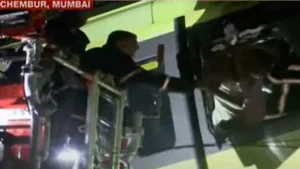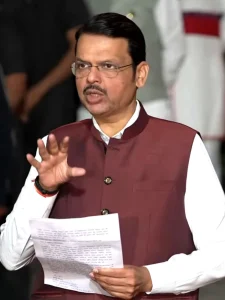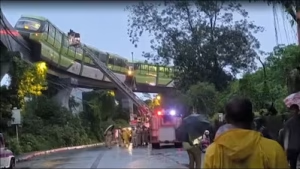Maharashtra – The Mumbai Monorail experienced a critical breakdown on Tuesday evening, stranding 400 passengers for over two hours amid heavy rainfall that has been battering the financial capital. The incident occurred around 6:15 PM between Chembur and Bhakti Park stations, transforming a routine commute into an emergency rescue operation that required immediate intervention from multiple agencies.
The Mumbai Monorail breakdown was attributed to a minor power supply issue, according to the Mumbai Metropolitan Region Development Authority (MMRDA). This technical failure on the elevated track system created a challenging rescue scenario that tested the city’s emergency response capabilities during adverse weather conditions.
Overcrowding Compounds Technical Difficulties

Maharashtra Deputy Chief Minister Eknath Shinde revealed that the Mumbai Monorail incident was exacerbated by severe overcrowding, which caused a section of the train to tilt dangerously. “Due to the closure of the Harbour line, many passengers were diverted towards the monorail. Due to the overcrowding, it tilted and there was also a power failure,” Shinde explained.
The Mumbai Monorail system faced unprecedented passenger load as commuters sought alternative transportation following the suspension of Harbour line services due to heavy rainfall. This diversion of passengers to the Mumbai Monorail created conditions that contributed to both the technical malfunction and the subsequent rescue challenges.
Immediate Emergency Response Coordination


The Mumbai Monorail emergency triggered a coordinated response from multiple agencies, with the Brihanmumbai Municipal Corporation’s fire brigade leading rescue operations. Passengers trapped in the Mumbai Monorail immediately contacted the BMC helpline number 1916 for assistance, demonstrating the importance of emergency communication systems during transport crises.
“Responding promptly, the Mumbai Fire Brigade rushed to the spot and began rescue operations with the help of three snorkel vehicles,” the BMC confirmed. The Mumbai Monorail rescue operation required specialized equipment to safely evacuate passengers from the elevated track system while ensuring their safety during the complex extraction process.
Passenger Safety and Evacuation Progress


Chief Minister Devendra Fadnavis provided assurance regarding the Mumbai Monorail incident, emphasizing that all passengers would be safely evacuated. “I request everyone to remain patient. I am in contact with the MMRDA Commissioner, the Municipal Commissioner, the police, and all relevant agencies,” Fadnavis posted on social media.
By the time of reporting, rescue teams had successfully evacuated 200 passengers from the stranded Mumbai Monorail, with operations continuing to extract the remaining passengers safely. The Mumbai Monorail rescue demonstrated the effectiveness of coordinated emergency response despite challenging weather conditions and technical complexities.
Government Leadership and Crisis Management
Deputy Chief Minister Shinde emphasized that the government’s immediate priority was rescuing all passengers trapped in the Mumbai Monorail. “Our priority right now is to rescue all passengers. There are nearly 200 passengers stuck inside. Our medical team is also on the spot. I urge the passengers not to panic,” Shinde stated.
The Mumbai Monorail incident prompted high-level government involvement, with both the Chief Minister and Deputy Chief Minister personally monitoring the situation and coordinating with relevant agencies. This leadership engagement ensured adequate resource allocation for the Mumbai Monorail rescue operation.
Also Read: Who Is B Sudarshan Reddy? Opposition’s Powerful Candidate Against NDA’s Radhakrishnan
Technical Response and Operational Challenges
The MMRDA confirmed that operations and maintenance teams were deployed immediately to address the Mumbai Monorail technical issues. “Our operations and maintenance teams are already on-site and working to resolve it quickly,” the authority stated, demonstrating institutional preparedness for such emergencies.
The Mumbai Monorail breakdown highlighted vulnerabilities in the city’s public transportation infrastructure during extreme weather events. The combination of power supply issues and overcrowding created a perfect storm that challenged the Mumbai Monorail system’s operational capabilities.
Passenger Experience and Safety Concerns

Visual evidence from the Mumbai Monorail incident showed frightened passengers attempting to break windows before professional rescue operations commenced. These scenes underscored the psychological stress experienced by passengers trapped in the elevated Mumbai Monorail system during the emergency.
The Mumbai Monorail passengers’ ordeal lasted over two hours, creating significant anxiety and discomfort. However, the coordinated rescue effort involving fire brigade personnel with specialized equipment ensured systematic and safe evacuation from the stranded train.
Weather-Related Transport Disruptions
The Mumbai Monorail breakdown occurred against the backdrop of severe weather conditions that have disrupted normal life across Mumbai for two consecutive days. Heavy rainfall flooded streets, stranded commuters, and created challenging conditions for vehicles navigating inundated roads throughout the city.
Chief Minister Fadnavis revealed that Mumbai witnessed record rainfall of nearly 300 millimeters, significantly impacting the city’s transportation network. The suburban train system, often called Mumbai’s lifeline, slowed considerably, while the Mithi river reached dangerous levels, necessitating evacuation of 400-500 people from vulnerable areas.
Official Investigation and Future Preparedness
Chief Minister Fadnavis announced that a comprehensive inquiry would be conducted into the Mumbai Monorail incident to prevent similar occurrences in the future. “An inquiry will also be conducted into why this incident occurred,” he confirmed, emphasizing accountability and system improvement.
This investigation into the Mumbai Monorail breakdown will likely examine technical failures, overcrowding management, emergency response protocols, and weather-related operational procedures. The findings may influence future operational guidelines and infrastructure upgrades for Mumbai’s elevated transport systems.
Lessons for Urban Transportation Resilience
The Monorail emergency highlights critical lessons for urban transportation resilience in megacities facing extreme weather events. The incident demonstrated both the vulnerabilities of modern transport infrastructure and the importance of robust emergency response capabilities when systems fail.
As Mumbai continues to expand its public transportation network, the Monorail breakdown provides valuable insights for improving system reliability, passenger safety protocols, and emergency response coordination. These lessons will prove essential for ensuring transportation security during future monsoon seasons and extreme weather events.

